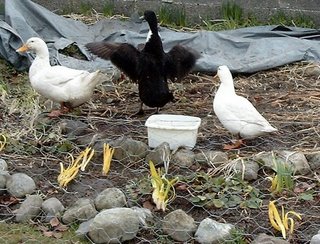
 Our school is situated about four miles east of the town of Athenry, Co. Galway. It is an eight teacher school - six class teachers, a Learning Support Teacher and a Resource Teacher. The school has six classrooms, a staffroom and small kitchen. Even though our school is bursting at the seams and appears small, yet, I am sure, it would appear palatial to those who founded the original school on a site nearby.
Our school is situated about four miles east of the town of Athenry, Co. Galway. It is an eight teacher school - six class teachers, a Learning Support Teacher and a Resource Teacher. The school has six classrooms, a staffroom and small kitchen. Even though our school is bursting at the seams and appears small, yet, I am sure, it would appear palatial to those who founded the original school on a site nearby.
The year 2006 is a special year in the history of our school. We are celebrating 150 years in education in Newcastle. The very first school was built on a site opposite this one 150 years ago in 1856. It was built by local contributions nine years after the social upheaval of the Famine of 1847. It is unlikely that local people had much money to spare. In spite of this however enough money was raised to build a school. It is very likely that the school was built by local labour as well as local contributions. This would have helped to keep costs at a minumum. The original building was made of wood and nothing of its structure remains today.
The official opening of the first school was performed on the 5th. of May 1856. We can only wonder at what that day must have been like as no written account of it has come down to us except a single entry in a Roll Book telling us when the official opening took place. Many questions have been left to our imaginations to answer. What must the celebrations have been like? How were the pupils dressed? How were the teachers dressed? What size were the classrooms? How many pupils first attended on the opening of the school ? Did all children of school going age go to school? At what age did the pupils leave primary school? The answers to some of these questions are to be found on the photograph of the first page of the roll book dated 1856, directly underneath this text.
 The day the school opened for the first time must have been a very special day in the lives of the people of Newcastle. The school's founders must have been conscious of the beginning of a new era, of the casting off of an era of discrimination when Catholics were not allowed to own or run a school and the beginning of a new era of hope for a better educated population with greater opportunities and a better life in the future.
The day the school opened for the first time must have been a very special day in the lives of the people of Newcastle. The school's founders must have been conscious of the beginning of a new era, of the casting off of an era of discrimination when Catholics were not allowed to own or run a school and the beginning of a new era of hope for a better educated population with greater opportunities and a better life in the future.
The school was first recognised as a National School on 1st. of June 1856.









